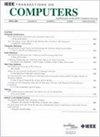基于内存约束的面向大项目数据流挖掘的高效草图
IF 3.8
2区 计算机科学
Q2 COMPUTER SCIENCE, HARDWARE & ARCHITECTURE
引用次数: 0
摘要
准确、快速的数据流挖掘对于许多任务至关重要,包括移动传感器数据的实时序列分析、大数据管理和机器学习。各种面向重型的项目检测任务,如识别重型打击者、重型改变者、持久项目和重要项目,已经引起了工业界和学术界的广泛关注。不幸的是,随着数据流速度的不断提高,可用内存(特别是L1缓存中的内存)用于实时处理的能力仍然有限,现有方案在同时实现高检测精度、内存效率和快速更新吞吐量方面面临挑战。为了解决这个难题,我们提出了一个名为Tight-Sketch的通用而优雅的草图框架,它支持一系列基于重型的检测任务。认识到,在实践中,大多数项目是冷的(非重/持久/重要),我们对不同的项目类型实施不同的驱逐策略。这种方法允许我们快速丢弃潜在的冷物品,同时为热物品(重/持久/重要)提供增强的保护。此外,我们还引入了一种基于随机衰减的剔除方法,以确保Tight-Sketch只产生很小的单侧误差而不会产生高估。为了进一步提高在极度受限的内存分配下的检测准确性,我们引入了一种包含两种优化策略的变体Tight-Opt。我们在各种检测任务中进行了广泛的实验,以证明Tight-Sketch在准确性和更新速度方面显着优于现有方法。此外,通过使用单指令多数据(SIMD)指令,我们将Tight-Sketch的更新吞吐量提高了36%。我们还在FPGA上实现了Tight-Sketch,以验证其在硬件部署中的实用性和低资源开销。本文章由计算机程序翻译,如有差异,请以英文原文为准。
Efficient Sketching for Heavy Item-Oriented Data Stream Mining With Memory Constraints
Accurate and fast data stream mining is critical to many tasks, including real-time series analysis for mobile sensor data, big data management and machine learning. Various heavy-oriented item detection tasks, such as identifying heavy hitters, heavy changers, persistent items, and significant items, have garnered considerable attention from both industry and academia. Unfortunately, as data stream speeds continue to increase and the available memory, particularly in L1 cache, remains limited for real-time processing, existing schemes face challenges in simultaneously achieving high detection accuracy, memory efficiency, and fast update throughput, as we reveal. To tackle this conundrum, we propose a versatile and elegant sketch framework named Tight-Sketch, which supports a spectrum of heavy-based detection tasks. Recognizing that, in practice, most items are cold (non-heavy/persistent/significant), we implement distinct eviction strategies for different item types. This approach allows us to swiftly discard potentially cold items while offering enhanced protection to hot ones (heavy/persistent/significant). Additionally, we introduce an eviction method based on stochastic decay, ensuring that Tight-Sketch incurs only small one-sided errors without overestimation. To further enhance detection accuracy under extremely constrained memory allocations, we introduce Tight-Opt, a variant incorporating two optimization strategies. We conduct extensive experiments across various detection tasks to demonstrate that Tight-Sketch significantly outperforms existing methods in terms of both accuracy and update speed. Furthermore, by utilizing Single Instruction Multiple Data (SIMD) instructions, we enhance Tight-Sketch’s update throughput by up to 36%. We also implement Tight-Sketch on FPGA to validate its practicality and low resource overhead in hardware deployments.
求助全文
通过发布文献求助,成功后即可免费获取论文全文。
去求助
来源期刊

IEEE Transactions on Computers
工程技术-工程:电子与电气
CiteScore
6.60
自引率
5.40%
发文量
199
审稿时长
6.0 months
期刊介绍:
The IEEE Transactions on Computers is a monthly publication with a wide distribution to researchers, developers, technical managers, and educators in the computer field. It publishes papers on research in areas of current interest to the readers. These areas include, but are not limited to, the following: a) computer organizations and architectures; b) operating systems, software systems, and communication protocols; c) real-time systems and embedded systems; d) digital devices, computer components, and interconnection networks; e) specification, design, prototyping, and testing methods and tools; f) performance, fault tolerance, reliability, security, and testability; g) case studies and experimental and theoretical evaluations; and h) new and important applications and trends.
 求助内容:
求助内容: 应助结果提醒方式:
应助结果提醒方式:


